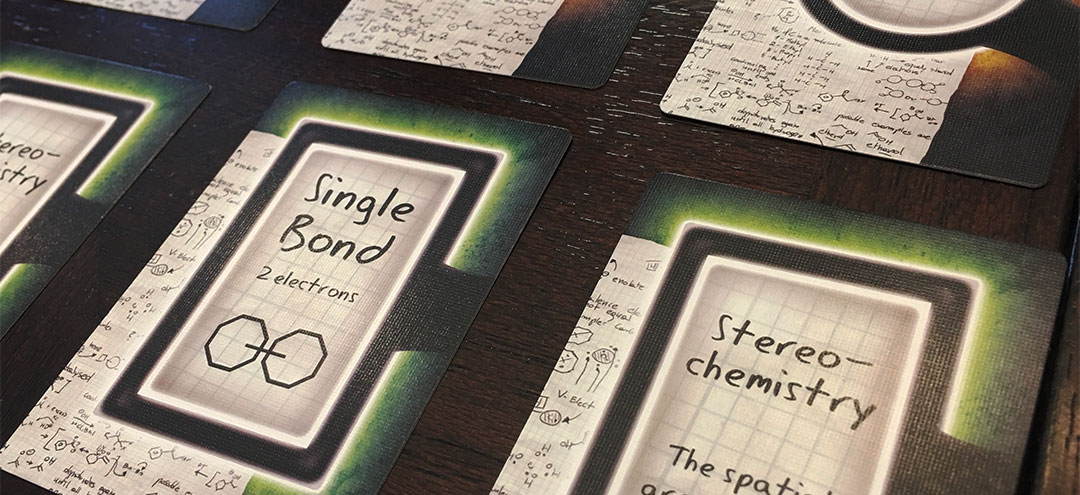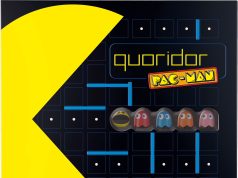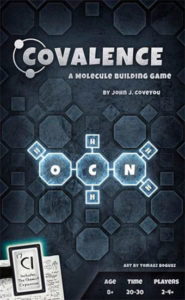 As a science teacher, I am always intrigued any time a game comes along with a theme or mechanics based on real-world science. Since many stopped paying attention to science once they left high school (and some even before then), games involving science can be both entertaining and educational, which warms my teacher heart.
As a science teacher, I am always intrigued any time a game comes along with a theme or mechanics based on real-world science. Since many stopped paying attention to science once they left high school (and some even before then), games involving science can be both entertaining and educational, which warms my teacher heart.
Genius Games has been the vanguard in creating games that take science content and adapt it for the gaming table and we have been impressed with Ion and Cytosis. Today we will discuss Covalence, where players attempt to deduce the structure of unknown organic compounds by following clues and a set of construction guidelines. Read on to see if Covalence can create a strong bond between itself and your game collection!
Covalence is a cooperative deduction game for 2-4 players. It plays well at all player counts, but plays best with 3 or 4 players.
Gameplay Overview:
One player takes on the role of the Knower, who looks at the hidden structure of the compounds that the rest of the players, known as Builders, need to construct. Each Builder gets a set of atoms tiles (carbon, hydrogen, nitrogen and oxygen) each double-sided to provide various options for bonding. Clue and guess tokens are then assigned to the builders based on player count and desired game difficulty, with less tokens for a harder game. Three unknown compounds are then dealt out to each player, with difficulty of the compounds adjustable based, the level of challenge.

During the course of the game, the Builders gain clues, which take the form of a structural clue and one or more number clues, that are given to them by the Knower, who has seen the hidden structure that needs to be deduced. For instance, the combination of ‘carbon’ and a ‘2’ clue would let the builder know that their molecule contains 2 carbons, while a ‘stereochemistry’ card clues them in to rearrange their current count of atoms. Builders each get one clue for free at the beginning of the game, but then have to spend clue tokens to receive a clue as the game continues.
Once all builders feel they are confident in their structures, they can spend a guess token to see if their molecular construction is a success. Each correct structure awards the Builders back a clue token, and allows that Builder to move on to their next unknown molecule. If the Builders and Knower can work together to get all the molecules built before the guess tokens are exhausted, everyone wins!
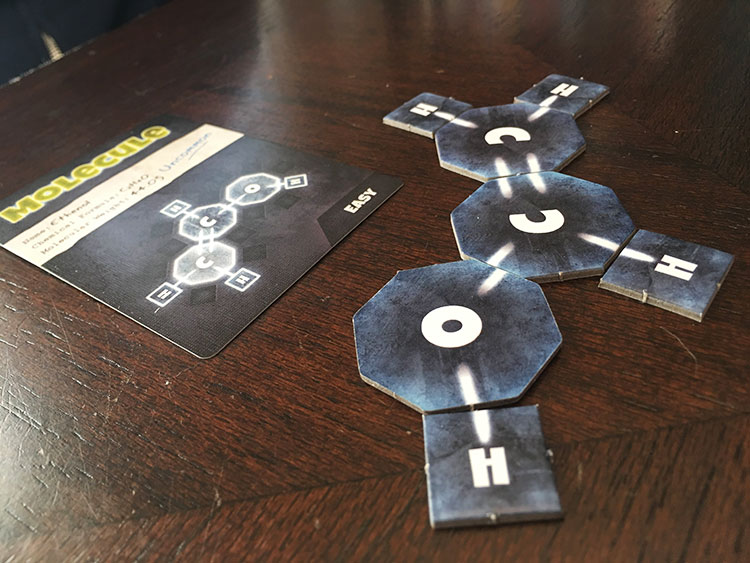
Game Experience:
Covalence, on the surface, can appear to be a bit intimidating to players who do not necessarily remember their high school chemistry. However, the game is designed to be accessible to the masses, without the need for an extreme depth of knowledge, which allowed both rules and gameplay to be understood quickly and easily. The element tiles are designed for easy understanding of how atoms can bond together, and guidelines for molecule construction provide limits, dialing back the complexity in what could be a difficult experience without any specific content knowledge. What Covalence does best is take the concepts of organic molecular geometry and make it accessible to the masses.
How the theme was accepted and enjoyed by everyone varied from player to player based on interest and background. For me, I thought it was innovative and engaging, while to others with less ranks in Science Nerd, they found the game to be quality but nothing standout or interesting about the theme.
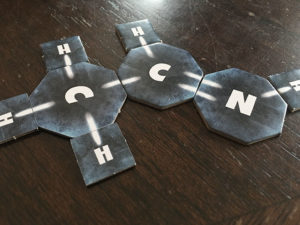
As the resident holder of a chemistry degree, it initially fell to me to be the Knower, a role which I was worried would get a bit boring after multiple plays. I was pleasantly surprised to find that my worries were unfounded, as being the granter of clues was just as rewarding of an experience as building the molecules. The rules provide that clue cards can be overlapped or played upside-down or combined, giving me quite a bit of flexibility and creativity in how to deliver clues. Another point of pride for Covalence is the fact that when we rotated roles, the new Knower (without my science background) was able to slide into that role easily.
A positive to Covalence was the variability in game setup by providing players a ‘difficulty setting,’ by increasing the difficulty of the unknown compounds to identify while dialing back the number of guesses and clues available. The game provides quite a challenge at the upper levels, with only especially deductive players being able to successfully guess their unknown structures at such a high level of complexity. It does provide a ‘Chemist expansion’ with another element (chlorine) and even more complicated molecules to construct.
While our plays of Covalence were generally positive, one of the drawbacks is that the game can feel somewhat repetitive in the role of the Builder after multiple plays, even with the variability in difficulty. While designed as a light and quick-playing game, this would not be a game that we would recommend for multiple consecutive plays in a gaming session.
Final Thoughts:
Covalence provides a great deduction with an ease in accessibility into what is, on the surface, a complex and difficult theme. It lets players adjust their difficulty based on player skill, and gives all players a rewarding game experience. You should find a time to play Covalence if you are interested in deduction games or games with a scientific theme. It is also recommended for families with students taking some physical science course, as it can help them reinforce chemistry concepts.
Final Score: 4 Stars – A great game. Worth checking out and adding to your collection.
 Hits:
Hits:
• Ease of accessibility with no chemistry degree required
• Creativity and flexibility in giving clues
• Adjustable difficulty
Misses:
• Theme can be hit-or-miss
• Can be repetitive after multiple consecutive plays







